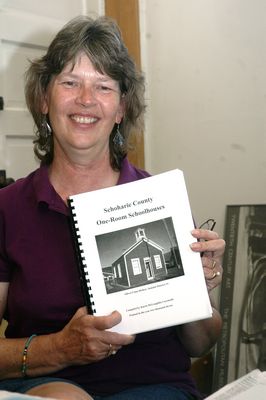Subscriptions
Menu
Advertisements
Book looks at local one-room schoolhouses
8/16/2011 |
By Jim Poole |

A new book by Karen Cuccinello focuses on the roots of Schoharie County's educational system:
The more than 250 one-room schoolhouses that taught generations of children.
A Summit resident for 33 years and the Times-Journal's Summit correspondent, Ms. Cuccinello completed "Schoharie County One-Room Schoolhouses" in a year of determined research.
She was intrigued by Summit's Oliver Schoolhouse, which stood on Charlotteville Road and was dismantled and reassembled at the Old Stone Fort in Schoharie in the 1980s.
Intending to study only Summit schoolhouses, Ms. Cuccinello soon found such a narrow scope was impossible.
"A lot of towns shared schoolhouses with other towns or counties," she said, "so I couldn't just do Summit."
But Ms. Cuccinello did set limits. Information was sketchy about the first schoolhouses, around 1790, and many towns drew school district boundaries in the early 1800s. So she settled on 1820 as a starting point.
The result is a 136-page comb-bound book that traces schools in each town, includes many photos of schools and teachers, has a detailed list of schools and an index of teachers.
Ms. Cuccinello combed through volumes of old newspapers from the region--even more than a century ago, schools liked to publicize their goings-on--but also interviewed many people who had attended the schools.
They weren't too difficult to track down; the last one-room schoolhouses closed in Sharon and Esperance in 1968.
"They have vivid memories of their one-room schoolhouses," Ms. Cuccinello said. "We often remember only bad things, but these people all had fond memories.
"They were tight little groups that walked to school together, learned together and played at recess together."
Many also recalled that learning came quickly because the younger kids could overhear the older students' lessons, Ms. Cuccinello said.
Newspapers were essential communicators, too, because they'd list when schools opened, who the teacher was and whether they closed because of snow or illness.
"If people hadn't written that down, there wouldn't be anything for people like me to look up 100 years later," Ms. Cuccinello said.
She also used town records and local gazettes--the precursor of phone books--which often listed teachers. Her schoolhouse book lists 925 teachers.
Some could be confusing. Ms. Cuccinello writes that she's "fairly certain that Mildred J. VanWormer, Mildred J. Barber, Mrs. Floyd Barber, Mildred Barber and Mildred Barker are all one and the same."
She located or knew of more than 250 schoolhouses, about 70 of which are still standing. Ms. Cuccinello lists them by their common names in her book and has notes from their past years.
"The hardest part was stopping," Ms. Cuccinello said. "I'd think I was done, and then someone would call with something else.
"I know the work isn't done. I know there are more schoolhouses out there."
Some tidbits from the book:
•Blenheim had one of the smallest schoolhouses. The Darling Hollow School was 20 by 20 feet.
•Schoharie had the only school for African-American children.
•Madison A. Rickard started teaching at age 16 in 1893. He taught at Ecker Hollow, Warnerville, East Cobleskill, Barnerville and Bramanville until 1921.
•Huntersland's old schoolhouse was sold to John Meeker for $7.25 in 1845.
•Many non-centralized schools participated in a play-day in 1938.
•At Kemper Mountain School in Gilboa, Lillian Warner was the lone student and also served as the school janitor in 1940.
• • •
Although Ms. Cuccinello's book is a compendium of old-time education, its production is a story, too.
Most local authors "self-publish" by taking their work to a printer. Ms. Cuccinello did them one better.
She photocopied issues of the book, found leftover comb binders from another project and assembled books herself.
"This is not a first-edition printing," she laughed. "If I need more, I can just run them off."
Ms. Cuccinello's "Schoharie County One-Room Schoolhouses" is available at Catnap Books in Cobleskill" or from Ms. Cuccinello herself, karenc@midtel.net.









